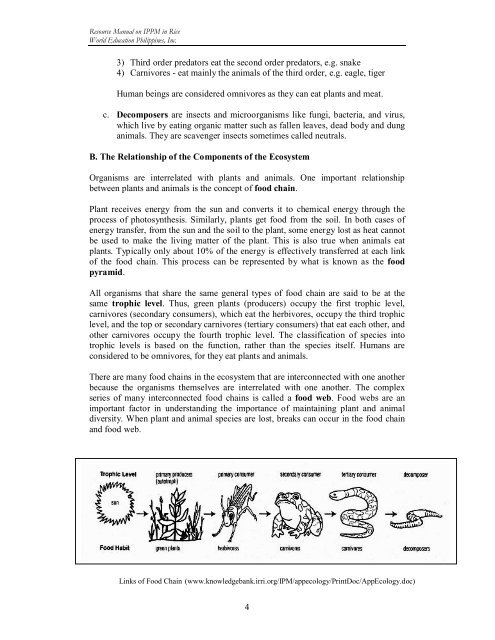(IPPM) in Vegetables - Vegetableipmasia.org
(IPPM) in Vegetables - Vegetableipmasia.org
(IPPM) in Vegetables - Vegetableipmasia.org
Create successful ePaper yourself
Turn your PDF publications into a flip-book with our unique Google optimized e-Paper software.
Resource Manual on <strong>IPPM</strong> <strong>in</strong> Rice<br />
World Education Philipp<strong>in</strong>es, Inc.<br />
3) Third order predators eat the second order predators, e.g. snake<br />
4) Carnivores - eat ma<strong>in</strong>ly the animals of the third order, e.g. eagle, tiger<br />
Human be<strong>in</strong>gs are considered omnivores as they can eat plants and meat.<br />
c. Decomposers are <strong>in</strong>sects and micro<strong>org</strong>anisms like fungi, bacteria, and virus,<br />
which live by eat<strong>in</strong>g <strong>org</strong>anic matter such as fallen leaves, dead body and dung<br />
animals. They are scavenger <strong>in</strong>sects sometimes called neutrals.<br />
B. The Relationship of the Components of the Ecosystem<br />
Organisms are <strong>in</strong>terrelated with plants and animals. One important relationship<br />
between plants and animals is the concept of food cha<strong>in</strong>.<br />
Plant receives energy from the sun and converts it to chemical energy through the<br />
process of photosynthesis. Similarly, plants get food from the soil. In both cases of<br />
energy transfer, from the sun and the soil to the plant, some energy lost as heat cannot<br />
be used to make the liv<strong>in</strong>g matter of the plant. This is also true when animals eat<br />
plants. Typically only about 10% of the energy is effectively transferred at each l<strong>in</strong>k<br />
of the food cha<strong>in</strong>. This process can be represented by what is known as the food<br />
pyramid.<br />
All <strong>org</strong>anisms that share the same general types of food cha<strong>in</strong> are said to be at the<br />
same trophic level. Thus, green plants (producers) occupy the first trophic level,<br />
carnivores (secondary consumers), which eat the herbivores, occupy the third trophic<br />
level, and the top or secondary carnivores (tertiary consumers) that eat each other, and<br />
other carnivores occupy the fourth trophic level. The classification of species <strong>in</strong>to<br />
trophic levels is based on the function, rather than the species itself. Humans are<br />
considered to be omnivores, for they eat plants and animals.<br />
There are many food cha<strong>in</strong>s <strong>in</strong> the ecosystem that are <strong>in</strong>terconnected with one another<br />
because the <strong>org</strong>anisms themselves are <strong>in</strong>terrelated with one another. The complex<br />
series of many <strong>in</strong>terconnected food cha<strong>in</strong>s is called a food web. Food webs are an<br />
important factor <strong>in</strong> understand<strong>in</strong>g the importance of ma<strong>in</strong>ta<strong>in</strong><strong>in</strong>g plant and animal<br />
diversity. When plant and animal species are lost, breaks can occur <strong>in</strong> the food cha<strong>in</strong><br />
and food web.<br />
L<strong>in</strong>ks of Food Cha<strong>in</strong> (www.knowledgebank.irri.<strong>org</strong>/IPM/appecology/Pr<strong>in</strong>tDoc/AppEcology.doc)<br />
4




![Section 4 [ PDF file, 252 KB] - The Field Alliance](https://img.yumpu.com/51387260/1/158x260/section-4-pdf-file-252-kb-the-field-alliance.jpg?quality=85)












